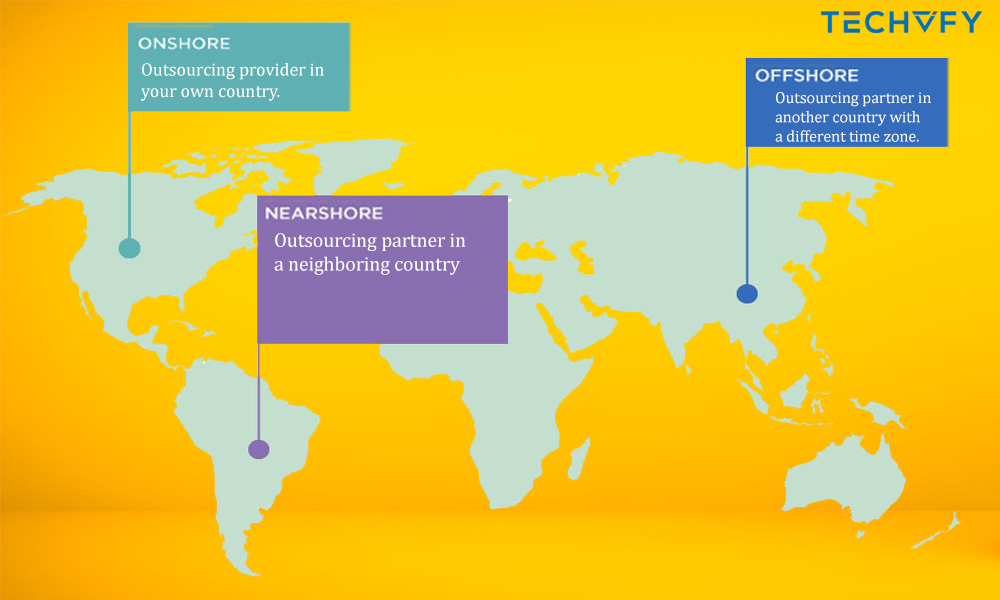Offshore Outsourcing Pros and Cons: All Your Need to Know
There are many situations in which you need to resort to external resources or third parties in foreign countries to handle your business operation.
People call this an offshoring strategy. It can optimize your business’s productivity and provide impressive results.
In the age of information and the internet, it has become easier to seek external services. This strategy helps operations become more flexible and avoids wasting unnecessary costs.
If you want to get your business off the ground with this strategy, this article will provide you with detailed information you should prepare.
You will have a clearer look under which conditions you should use it. Also, it is a chance to learn about the benefits of this plan and figure out the types of offshoring companies that suit your business.
What Is Offshore Outsourcing?
Offshoring is the activity of hiring a foreign company that specializes in handling specific tasks your company may need. They will take charge of your company’s operation outside your country using online contact. These services are generally cheaper than the ones in your location.
The labor costs in some regions are much higher than in other parts of the world. Therefore, it is hard to recruit employees who can handle your business tasks. In some cases, your business may lack the facilities needed for production, and buying them overseas is very expensive.
You should use the offshoring strategy if these obstacles interfere with your company’s operation. The critical thing is to hire the right people suitable for your business. They can do difficult tasks much faster with high productivity.
Related Articles:
Types Of Outsourcing
There are many popular types of oversea services. You should assess each one’s advantages and weaknesses to make the most optimal selection.

Offshoring (Offshore Outsourcing)
Production offshoring or business process outsourcing is the most common offshore outsourcing example. This strategy relocates the manufacturing process to an overseas location.
By doing this, you can take advantage of the cheap costs of labor and facilities in that region.
An extra advantage is the low manufacturing and production taxes. A prime example is Asian countries with abundant workforces working at low wages.
This method reduces a large amount of production expense and increases the number of products.
The drawback of this strategy is the lack of intellectual property laws. The others can easily copy your company’s products and technology.
You also need to handle recruitment and bookkeeping, which are hard to manage overseas.
Onshore outsourcing
Onshore outsourcing or Local outsourcing is widely known as domestic outsourcing. This strategy involves the recruitment of one software outsourcing company in your country, which is more convenient and accessible. With these benefits, it comes at a higher cost compared to production offshoring.
As the people living in your country speak the same language and share a general culture, you can communicate with each other more efficiently.
The working hours and time zones are the same for both parties so that you can share a working schedule.
Hiring local businesses also lowers the risk of stealing intellectual property. If any problems arise, you can come to the location and deal with them directly.
It is easier to manage the workforce and observe the manufacturing process.
Nearshore Outsourcing
This strategy involves outsourcing services to Eastern Europe rather than the Asia market. Specialists in Eastern Europe countries excel at technologies and computer software.
If you are working in technological fields, nearshore outsourcing is a perfect selection.
Laborers in these regions have a great command of English and work in nearly the same time zones. They take great responsibility for your work and provide your projects with full support.
When it comes to their fortes, handling tasks that involve innovation and creativity should come first.
Such a profile explains why nearshore outsourcing is generally more expensive than the services in Asian countries.
Pros And Cons Of Offshore Outsourcing
Here are some offshore outsourcing pros and cons to help you choose suitable offshore software development services for your company.
Advantages of offshore outsourcing
Reduce Costs
One of the offshore outsourcing advantages is the amount of money and resources it can save for businesses. You do not have to pay high taxes when shifting production to some regions. The costs of production and labor are also lower in Asian countries.
You can use the saved resources to reinvest in developing your products and enhance growth. Overseas outsourcing optimizes your revenues and also creates job opportunities for workers in the regions.
Improve Your Projects’ Quality
Access to specialists with high skills and knowledge is one of the greatest benefits of offshoring. IT and technology companies can collaborate with offshore services in Eastern Europe. They have expertise in these fields and can handle difficult tasks.
These services can guarantee your products’ quality, as they do the tasks with full support and responsibility for work.
Asia, notably China, the Philippines, and Vietnam, is also a promising market to step into. These countries have witnessed dramatic growth in the IT industry while keeping costs reasonable.
Future Of Offshore Outsourcing
The future of offshore outsourcing is very promising, with much potential to develop. When technology reaches higher levels, the language hurdles can be surpassed. You can seek outsourcing services from any corner of the world.
Disadvantages of offshore outsourcing
Different Time Zones And Languages
People have different working times and speak different languages in many regions of the world, and you cannot communicate efficiently with oversea outsourcing services. It is time-consuming and costly to hire a translator.
Different time zones lead to delays in production. If any problems come up, you cannot contact the collaborators and fix them instantly.
Foreign Regulations
The laws and regulations in different countries are not the same. You should grasp all the regulations of the location you are shifting production to. Ensure that you can prove the ownership of your company’s products and technology.
Other people could steal your projects and not get punished by the laws in their countries. This is a major example of offshore outsourcing’s disadvantages. Find a trustworthy outsourcing service with a years-long reputation working in this field.
Conclusion
Offshore Outsourcing is a great tactic to improve your company’s productivity and reduce costs at the same time.
Select the right services depending on your type of operation and the business’s goals. They can bring your company a lot of benefits and enhance long-term growth.





